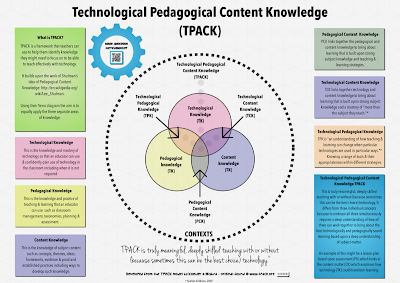I started with the PK (Pedagogical knowledge) and the CK (Content knowledge) circles because I felt confident with the them. As a teacher, my PK are the practices and methods that I use for teaching and learning. It's me knowing how students learn and using strategies that would suit their learning needs. My CK is everything I know about my subject area alongside knowing what students need to know to achieve success. When you combine the two, you get the PCK (Pedagogical Content Knowledge) is basically knowing how to teach the content effectively(and be able to assess it and report on it).
At this stage, I have made the PK and CK circles bigger then the TK (Technological Knowledge) because I am not an expert in the area of blogging as the technological tool. The TK is where I need to know how to use the tool effectively to achieve effective outcomes. The TPK (Technological Pedagogical Knowledge) is where "an understanding of how teaching and learning can change when particular technologies are used in a particular way" (Koehler & Mishra, 2009). It is like understanding the need to use digital feedback for example in your teaching and planning because it is good practice.
The TCK (Technological Content Knowledge) could be about using the technology to enhance the learning of my subject and teachers being aware of opportunities to utilise mediums other than the ones they are used to.
Lastly is the 'sweet spot' or the TPACK (Technological Pedagogical Content Knowledge) which is where all of the 3 knowledge areas meet. Koehler & Mishra (2009) study of TPACK defines the framework as follows:
TPACK is the basis of effective teaching with technology, requiring an understanding of the representation of concepts using technologies; pedagogical techniques that use technologies in constructive ways to teach content; knowledge of what makes concepts difficult or easy to learn and how technology can help redress some of the problems that students face; knowledge of students’ prior knowledge and theories of epistemology; and knowledge of how technologies can be used to build on existing knowledge to develop new epistemologies or strengthen old ones” (Koehler & Mishra, 2009).
On my diagram, I have highlighted in yellow examples of how I would apply TPACK in my teaching and learning area of social studies with the content based around a year 9 study that my students are currently completing on 'Our Government'.
 |
| The parts in yellow show an example of applying a social studies context |
My innovation lies in the use of our Manaiakalani model of Learn, Create, Share at the centre of TPACK to enhance student learning - how can we get it right at the core of TPACK with what we know works?? I have drafted an example of a possible assessment using TPACK, which I know could do with defining and developing further!
I am really happy with my TPACK framework take 1 model because it has helped me get back on track with my MIT inquiry! I look forward to sharing more information on my TPACK journey as I investigate further how to make sure we hit that sweet spot right!
(My scribbles are an important part of the planning process hence why I have chosen to show them here).
















